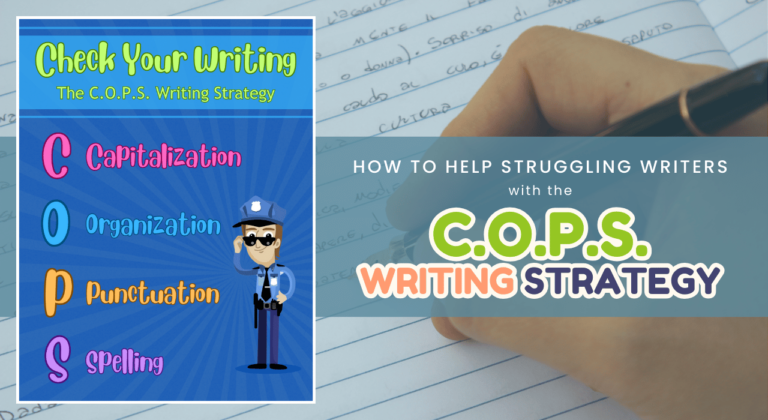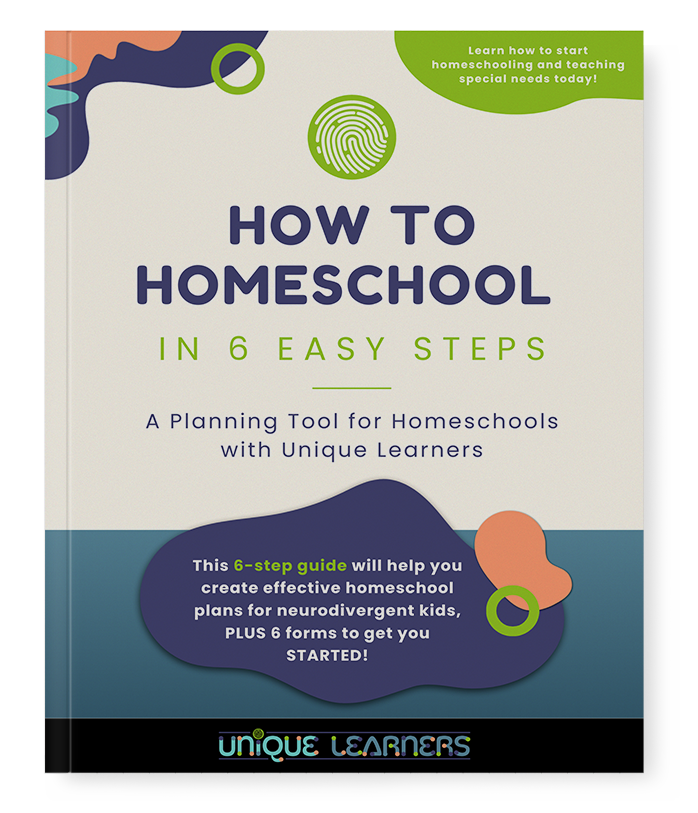Teaching writing can be challenging, especially when working with students who struggle with special needs written expression. As educators, we often wonder how we can effectively evaluate and improve our students’ sentence writing skills. One useful writing strategy that can help make this task easier is the COPS method. COPS is an acronym that stands for Capitalization, Organization, Punctuation, and Spelling, and it can be used to assess and guide students towards writing better sentences. By teaching struggling writers how to evaluate sentence writing using COPS, you can help them become more confident and effective writers. In this blog post, we will discuss how to use COPS to evaluate sentence writing in a simple and practical way.

The Components of a Good Sentence
In elementary writing, it’s important to teach students the basics of constructing a good sentence. A good sentence should have two or three main components. I call a two component sentence as a “bare bones” sentence.
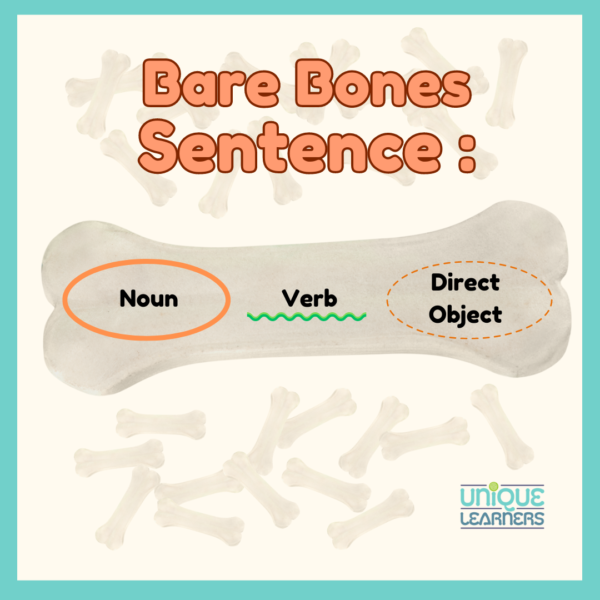
- a noun, which is the subject that tells what the sentence is about,
- the verb is the action or state of being, which is how the noun is acting or existing,
- and the object that is directly receiving the action.
It’s important to ensure that students understand the two and three components of a good sentence before moving on to more advanced writing skills. One way to reinforce this knowledge is to have students practice building sentences using color-coded shapes that embed the concept of each part of speech.
Identifying each grammatical function in given sentences and paragraphs can also serve as a foundation for teaching proofreading skills later on. I teach grammar with color-coded shapes for improving memory of each of the functions of the eight parts of speech. When students know what a complete sentence looks like, they are better equipped to recognize errors in writing.
Applying the COPS Writing Strategy Checklist
COPS stands for Capitalization, Organization, Punctuation, and Spelling. This simple yet effective writing strategy checklist is an essential tool for evaluating sentence writing, especially in elementary writing.
I have created this fun poster you can download to use as a reminder for yourself and your student as you practice writing. Grab your FREE poster from our shop HERE!
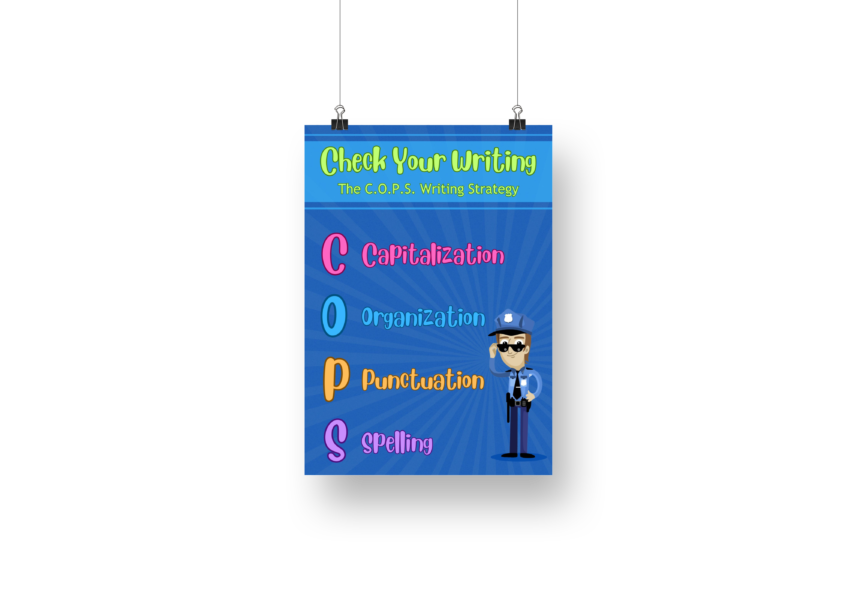
Capitalization
The first step in using the COPS writing strategy is to analyze capitalization. The student should be guided at first by the teacher every time to self-review capitalization in written work. Walk the student through the process of checking that the first letter of each sentence and proper noun is capitalized. Eventually, the student will know the capitalization rules easily.
Organization
The second step in the COPS writing strategy is organization. The writing should be organized in a way that makes sense to the reader. Encourage students to use descriptive language, sensory details, and vivid imagery to enhance their writing.
I have found that helping my students with language learning disabilities to check their organization is to restate the sentence they intended to write, and then count the number of words in the sentence. This helps the student practice phonemic awareness, as well as increase the accuracy of the words in the sentence. This also helps me to consider whether the student has mastered using the parts of speech that have already been taught and practiced, and whether it is time to add more parts of speech to their sentence writing.
By keeping these tips in mind, you can help improve elementary writing and teach important proofreading skills to your students. Another helpful tip is to provide feedback that is specific and constructive. Avoid simply pointing out errors and instead, provide suggestions for how to improve the sentence.
For example, instead of saying “this sentence doesn’t make sense,” try saying “this sentence could be clearer if you reworded it to include the subject and verb in the beginning.” This way, students can learn from their mistakes and make meaningful revisions to their writing.
Punctuation
Punctuation is the third component of the COPS writing strategy checklist. The writer should use appropriate punctuation marks to signal to the reader when to pause, stop, or continue reading. This includes using commas, periods, question marks, and exclamation marks in the right places.
Spelling
Finally, the fourth component in the COPS writing strategy is spelling. I reduce the stress about checking spelling because many kids with dyslexia or other learning issues will actually avoid writing just because of their own awareness that spelling is a weakness. I encourage my students that organization is the most important part of writing. It is the part of telling their ideas, and no one can know what is in their mind. Capitalization, punctuation, and spelling are called mechanics because someone else can fix them, like an auto mechanic. Even if a student can only write the first letter of a word, we can build from that.
On the other hand, reviewing spelling errors is an essential part of proofreading. Misspelled words can negatively affect the readability and credibility of the writing. This is the opportunity to help our students practice words that are in their active vocabulary.
Here is my sequence of scaffolded support for spelling:
Beginning writers. I frequently have my beginning writers dictate a sentence, copy it, and then proofread it, including comparing the spelling from my example to their sentence. My students always show me their work to spell check also, and of course, this provides opportunity to praise their writing. The child must always do something with their dictated writing by copying or typing from your example.
Praise reduces obsession and avoidance of writing due to anxiety about making mistakes in writing. Praise at this early stage is an absolute must!

Independent sentence writers. As a student advances to writing independent sentences, I will provide a correctly spelled example of each misspelled word in a sentence. With only one to three sentences, the student is less likely to have more than five misspelled words. From the list at the bottom of the page, the student should correct the mistakes in their sentences. I keep a list of writing errors. From that list, we practice spelling with fun, multisensory activities.
Intermediate paragraph writers. In teaching proofreading skills to intermediate writing students working on paragraphs, the COPS checklist can be an excellent resource. The organization step becomes checking for clear paragraph structure, as well as complete sentences.
Advanced essay writers. I even use the COPS proofing method with my high schoolers who tend to have a lot of fragments and run-on sentences in their writing. Many teens have forgotten the essential components of a sentence and have difficulty locating the noun and verb in their sentences. The analysis process also leads me to opportunities to teach about active and passive voice in sentence writing, as well as variety in sentence length.
When students review their own work by checking off each component, they can become more aware of their sentence writing habits and identify areas where they need improvement. By following the COPS checklist, evaluating sentence writing becomes easier and more straightforward. This evaluation strategy allows for a structured approach to editing and helps young writers identify common mistakes and improve their overall writing skills.
What about the 6 Traits of Writing – Writing Strategy
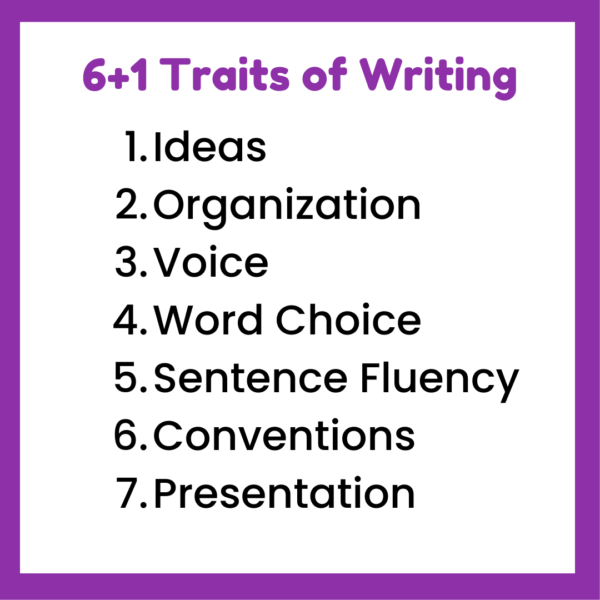
COPS is a useful tool; however, it is not the only method for evaluating sentence writing. It can be good practice for older or more advanced writers to use a checklist of the six traits of writing. I am not a fan of using the 6 Traits because many of my students struggle in just getting a basic sentence on paper. Structure typically leads to clarity of written communication more effectively than trying to focus on all six traits. I have also found the terminology of the six traits of writing is confusing and ignored by kids with language-based learning difficulties in writing.
Writing Strategy Tips for the Teacher to Encourage Writing
As you coach your writers to keep using the COPS checklist, there are a few things to keep in mind. It is essential to read your own writing multiple times, checking for each component individually. I have my students read their sentences aloud and point to each word as they say it. That way if a word has been omitted or a word was written twice by mistake, the student will be able to catch the errors.
Lastly, when editing, it is crucial to strike a balance between fixing errors and preserving the writer’s unique voice and dignity as a writer. While it is essential to correct mistakes, it is equally important not to alter the writer’s intended meaning or tone. We also don’t want to shut down young writers by whamming them with too many errors needing to be corrected.
If you have a student who makes mistakes in each of the four COPS components, you may want to focus on only one component at a time. If you are guiding your writer to check for capitals, you can make your own annotated notes on complete sentences, punctuation, and make a list of spelling errors. The child doesn’t even need to see your notes until you are ready to focus on each of the other component skills.
If you have a student who avoids any type of writing, reduce the expectations to the child’s ability level. Back up in the sequence of scaffolded support. Then practice more frequently. If you are writing only once a week, increase practice to two or three times a week. If you assign writing three times a week, try to do a little bit every day.
As students transition to paragraphs, once or twice a week is a good amount for kids with special needs. For essay writers, working on an essay for two weeks to a month may be necessary to learn the essay writing process.
Remember, a little more frequently is better than a lot less often for most students. Watch for a blog article describing my paragraph writing strategy. If you struggle in teaching or evaluating writing in your homeschool, consider joining the Unique Learners membership so that you have the support you need to more effectively help your kids who struggle in writing.
In summary, editing and proofreading are important skills that should be taught from a young age. By keeping these tips in mind and applying the COPS checklist, you can help students develop strong writing skills that will serve them well throughout their academic and professional careers. With modeling, guidance, and practice, writers can improve their sentence writing skills and create clear, concise, and effective written communication.
Grab your FREE e-book guide to revamp your homeschool for success!
Are you new to homeschooling, or just wanting a fresh start? Download our FREE “How to Homeschool in 6 Easy Steps” guide and get valuable insights from Sue’s 30+ years of experience as a special educator and homeschool mom of 4!
Want to know about new products and blogs?
Join our email newsletter to be the first to know about a new homeschool and special needs blog, and new products from our shop! Sign up for only the newsletter, or grab your FREE “How to Homeschool in 6 Easy Steps” guide and you will also be added to the newsletter!
Also, join our Facebook group!
Join our new “Homeschool Help for Special Needs” Facebook group! It is a place for homeschool moms to ask questions about homeschooling a child with special learning needs, share teaching and curriculum ideas that have worked (and those that bombed), and be real about the unique challenges of homeschooling with special needs. If you want to join us, be sure to answer the member questions to help us keep this private group secure. Join us now!
